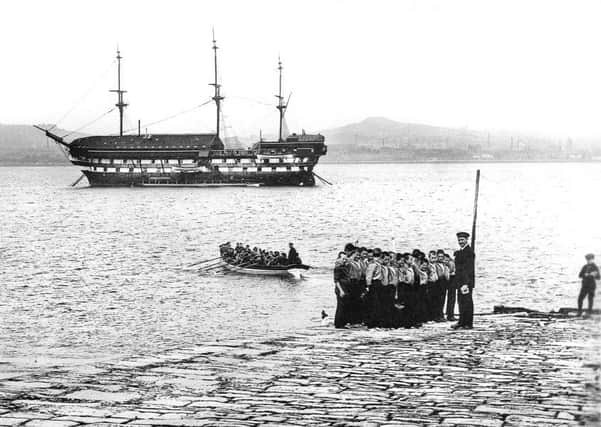The Dundee ship which housed and educated city's destitute boys


The idea was to spare hoards of destitute youngsters from a life of crime and prison with hopes to rehabilitate them with education and new skills.
Some were on board the Mars, which was moored at Woodhaven harbour on Wormit between 1869 and 1929, for offences as petty as stealing grapes, but many were orphans or sent there following the death of a parent.
Advertisement
Hide AdAdvertisement
Hide AdIn 1901, boys on board included John Aimer, 15, from Glasgow; Albert Dalgleish, 14, from Edinburgh; Thomas Donnelly, 12, from Glasgow and John McDonald, 14, from Thurso. Up to 400 boys could be housed on the Mars at any one time.
Historian and author Gordon Douglas, of Fife, has done much work to illuminate life on the Mars, a former battleship, and has written two books about the correctional vessel.
One account detailed by Douglas is that of Henry Thomson, 13, who was sent to the Mars after being caught stealing a bread roll.
“I had lost my father in the war, and recently lost my Mother to the fever, was now left on my own with no home and I was starving with hunger. The ‘Polis’ man said I was lucky to be sent to the Mars, as not that many years ago, I might have been sent to prison, or transported to a penal colony, like Australia,” the account said.
Some boys on board were as young as nine-years-old with seamanship, woodwork, metal work and tailoring among the skills taught to the youngsters.
While a welcome alternative to street life, existence was tough on the Mars and beatings common. Boys were generally referred to by their registration number, rather than their first name.
Those found to be behaving badly, such as trying to escape, smoking or thieving, were strapped over a gym-horse and beaten with the tawse.
Advertisement
Hide AdAdvertisement
Hide AdIn March 1871, three boys lost their lives whilst attempting to escape the ship in an open boat during a storm. A total of 39 boys died on the Mars and are buried in a mass grave at Vicarsford Cemetery, near Tayport.
While life on the ship was highly disciplined, there were more enjoyable moments too. A summer holiday to a camp site in Elie was organised each year - a 20-mile walk away - and the boys were allowed off the boat every Sunday to walk around the grounds of St Fort estate, albeit in total silence.
Mr Douglas has detailed how boys slept in hammock on the orlop deck at the very bottom of the boat, with one cover given in summer and two in winter.
They day started at 5am in the summer, with decks scrubbed for one-and-a-half hourse before a porridge breakfast.
The boys were split into two watches with one going to school on the ship while the others went to workshops ashore.
The last of the ship’s survivors died in 2001. He had been sent there when his father, a dock worker in Gravesend, was killed in an accident on the docks and his mother paid a substantial weekly sum for the dubious privilege of having her boy trained there.
Despite the harsh nature of much of Mars life, the project was generally hailed a success given most of the boys went on to become trained seamen and skilled workers.
